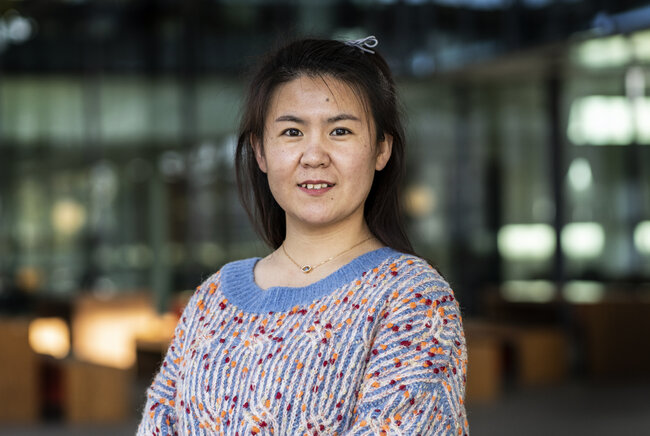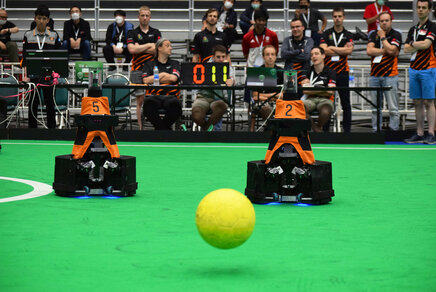A new way to create wave-like motion of arrays of miniaturized artificial cilia
Such wave-like motion or ‘metachrony’ plays an important role in flow generation in microfluidic chips.

In a new paper just published as part of her PhD research, Zhiwei Cui investigated magnetic artificial cilia, or ‘MAC’ for short, which are tiny flexible magnetic polymer hairs that can be made to move by applying a magnetic field. The MAC concept is inspired by biological cilia that are found in nature in many places, including in our own bodies, and can involved in the transportation of fluids or particles in fluids. For example, our airways are lined with many cilia that sway back and forth to transport mucus out of our lungs. In nature, the cilia tend to move collectively in a ‘wave-like’ manner, which is known as metachrony. Zhiwei and her collaborators studied a new and clever way to induce this same wave-like motion of natural cilia with MAC. She has used this to transport fluids in tiny channels, which can have applications in microfluidics, and Zhiwei also studied the effect of the wave-like motion on the induced flow. This new research is presented in a new paper published in the journal PNAS.
Biological cilia, hairlike organelles on cell surfaces, often exhibit collective wavelike motion known as metachrony, which helps generating fluid flow. Inspired by nature, researchers in the past have developed artificial cilia as microfluidic actuators, exploring several methods to mimic the metachrony. However, the devices created in these past efforts are difficult to miniaturize because they require either control of individual cilia properties or the generation of a complex external magnetic field.
Researchers at the Department of Mechanical Engineering Zhiwei Cui, Ye Wang, Tongsheng Wang, and Jaap den Toonder, in collaboration with Shuaizhong Zhang from the Max Planck Institute for Intelligent Systems in Stuttgart have devised a novel concept that generates metachronal motion of magnetic artificial cilia (MAC) even though the MAC are all identical and the applied external magnetic field is simple and uniform.
This effect is achieved by integrating a magnetic substructure in the substrate underneath the MAC. Uniquely, both symplectic metachrony (in which the wave travels in the flow direction) and antiplectic metachrony (in which the wave travels opposite to the flow direction) can be created by changing the relative positions of the MAC and substructure – both of these metachronies are also found in nature. Both types of metachronal motion were shown by the researchers to generate flow, just as in nature. The results prove that the metachrony plays an important role in flow generation, and that the effect depends on the metachronal wave propagation direction.

Breaking the size limitation
This research from lead author Zhiwei and her collaborators is a significant milestone. In contrast to previous solutions, her approach makes it possible to miniaturize the metachronal MAC, breaking the size limitation barrier in metachronal artificial cilia and making it possible to integrate them in small-scale microfluidic chips.
This achievement not only showcases the potential of nature-inspired engineering, but also opens up a host of exciting opportunities for designing and optimizing microsystems with enhanced fluid manipulation capabilities.
Potential applications include miniaturized medical diagnostic devices in which tiny amounts of blood can be analyzed, or in so-called ‘organ-on-chip’ devices that can be used for understanding diseases or to develop new medical drugs where precise fluid control is essential.
Crucial advancement
This is the first time that researchers have been able to realize the metachronal motion of small MAC, which can be miniaturized even further e.g., towards artificial cilia with biological dimensions, breaking the size limitation of earlier approaches and capturing two types of metachronal motion. It is also possible to adjust the wavelength of metachrony through the optimal design of the geometry of the magnetic substructure. The findings represent a crucial advancement towards the seamless integration of magnetic artificial cilia into microfluidic chips at a small scale.
Further information
"Miniaturized metachronal magnetic artificial cilia", Zhiwei Cui,Ye Wang, Shuaizhong Zhang, Tongsheng Wang, and Jaap M.J. den Toonder, PNAS, (2023).
This research was funded by the European Research Council (ERC) Advanced Grant Bio-Plan project under grant agreement no. 833214. Zhiwei Cui is financially supported by the China Scholarship Council under grant no. 201706400061.
Media Contact
Latest news


